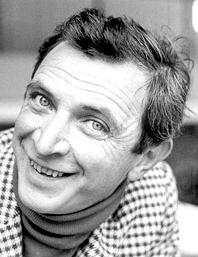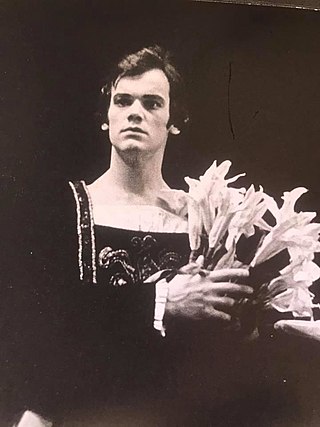Related Research Articles

John Cyril Cranko was a South African ballet dancer and choreographer with the Royal Ballet and the Stuttgart Ballet.

Stuttgart Ballet is a leading German ballet company. Dating back to 1609, then the court ballet of the dukes of Württemberg, the modern company was founded by John Cranko and is known for full-length narrative ballets. The company received the Laurence Olivier Award for Outstanding Achievement in Dance in 1981.
John Neumeier is an American ballet dancer, choreographer, and director. He was the Director and Principal Choreographer of Hamburg Ballet from 1973-2024 and the Artistic Director Ballet at Hamburg State Opera from 1996-2024.
Brahms–Schoenberg Quartet is a one-act ballet by George Balanchine, to Johannes Brahms's Piano Quartet No. 1, orchestrated by Arnold Schoenberg. The ballet premiered on April 21, 1966 at the New York State Theater, performed by the New York City Ballet.
Renato Zanella is an Italian-born ballet dancer, choreographer and director. He studied classical ballet for several years before becoming a choreographer for various professional companies. Due to his success, he has won many awards and honorary titles within the ballet community.
Barış Dilaver is a Turkish ballet dancer.

Richard Cragun was an American ballet dancer, teacher and ballet director who performed with the Stuttgart Ballet in Germany from 1965 to 1996.

Marcia Haydée Salaverry Pereira da Silva is a Brazilian ballet dancer, choreographer and ballet director. She was prima ballerina of the Stuttgart Ballet under John Cranko and succeeded him as the company's director, serving from 1976 to 1995. She has been director of the Santiago Ballet since 1992.
Ivan Cavallari is a dancer and choreographer and artistic director. He is currently at the head of the artistic direction of Les Grands Ballets Canadiens de Montréal.

Birgit Keil is a German ballet dancer. She was prima ballerina of the Stuttgart Ballet and was internationally known as The German Ballerina, She has been teaching at the Hochschule für Musik und Darstellende Kunst Mannheim and directing the ballet ensemble of the Badisches Staatstheater Karlsruhe.
Sonia Santiago is a ballet dancer and ballet teacher.
Requiem is a one-act ballet created by Kenneth MacMillan in 1976 for the Stuttgart Ballet. The music is Gabriel Fauré's Requiem (1890). The designer was Yolanda Sonnabend, who had first collaborated with him on 1963's Symphony.
Las Hermanas is a one-act ballet created by Kenneth MacMillan in 1963 for the Stuttgart Ballet. The music is Frank Martin's Harpsichord Concerto (1952). The piece is loosely based on The House of Bernarda Alba by Federico García Lorca.

The Song of the Earth is a ballet based on Das Lied von der Erde, a symphonic work written by the Austrian composer Gustav Mahler in 1908–1909. It is scored for two voices and orchestra, and has been used for ballets by several well-known choreographers, including Antony Tudor (1908–1987), Kenneth MacMillan (1929–1992), Heinz Spoerli, and John Neumeier.

Egon Madsen is a Danish ballet dancer, teacher, ballet master and company director. In 1961, he joined the Stuttgart Ballet, where John Cranko had become the director. Madsen was hired as a soloist but was soon promoted to principal dancer, and created numerous roles for Cranko. He retired from Stuttgart in 1981.

Stephen Jefferies is a retired ballet dancer, artistic director and choreographer. He was a senior principal dancer for The Royal Ballet and The National Ballet of Canada.

Onegin is a ballet created by John Cranko for the Stuttgart Ballet that premiered on 13 April 1965 at Staatstheater Stuttgart. The ballet was based on Alexander Pushkin's 1825–1832 novel Eugene Onegin, to music by Pyotr Ilyich Tchaikovsky and arrangements by Kurt-Heinz Stolze. The ballet has since been in the repertoires of The Australian Ballet, National Ballet of Canada, American Ballet Theatre and The Royal Ballet.
The Taming of the Shrew is a ballet in two acts choreographed by John Cranko to keyboard works by Domenico Scarlatti arranged and orchestrated by Kurt-Heinz Stolze. With scenery and costumes designed by Elizabeth Dalton, it was first presented as Der Widerspenstigen Zähmung by the Stuttgart Ballet at the Wṻrtembergische Staatstheater in Stuttgart on 16 March 1969.
Katarzyna Kozielska is a Polish ballet choreographer.
Anne Woolliams was an English artistic director, ballet choreographer, dancer and teacher. She began studying dance at age five, performing with the Russian Opera and Ballet, the Ballet de la Jeunesse Anglaise and the St. James' Ballet and danced in the film The Red Shoes and stage musicals. Woolliams taught at Folkwang School, was appointed ballet mistress of Stuttgart Ballet, founded the John Cranko School with the director John Cranko, was the third artistic director of The Australian Ballet, was dean of dance at Victoria College of Arts, Melbourne and was artistic director of the Vienna State Ballet.
References
- 1 2 3 Craine, Debra; Mackrell, Judith (19 August 2010). The Oxford Dictionary of Dance. p. 230. ISBN 978-0199563449.
- 1 2 3 4 5 6 Percival, John (1983). Theatre in My Blood: A Biography of John Cranko. ISBN 9780906969045.
- 1 2 3 4 Mathis-Masury, E. Hollister (2021). "John Cranko's Stuttgart Ballet: A Legacy". In Farrugia-Kriel, Kathrina; Nunes Jensen, Jill (eds.). The Oxford Handbook of Contemporary Ballet. doi:10.1093/oxfordhb/9780190871499.013.45. ISBN 9780190871499.
- 1 2 Parry, Jann (20 November 2013). "Stuttgart Ballet – Made in Germany bill – London". DanceTabs.
- ↑ Barnes, Clive (10 June 1973). "Dance". New York Times.
- ↑ Barnes, Clive (14 June 1975). "Dance: Stuttgart's 'Daphnis and Chloe' in Premiere". New York Times.